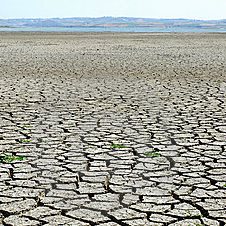Banner
Few remaining Jewish farmers pray for rain
Jewish Report spoke to two of just a handful of Jewish commercial farmers remaining in SA: Desmond Hyman and Darrel Kadish. Both farm a typical Highveld mix – beef cattle, potatoes and white and yellow maize. But their situations are very different. Kadish is monitoring global forecasts which, he says, “are showing possibly the worst El Niño ever”, and predict the hottest and driest summer in SA’s history. The fervent prayer remains: ‘Please G-d, give us rain…’

ANT KATZ
Five out of the country’s nine provinces have now been declared water disaster areas, as government’s inter-ministerial task team tries to come to grips with the twin disasters of record heat and low rainfall, causing one of South Africa’s worst droughts ever.
Long-term food security in the country is possibly more threatened than ever before.
The shortage of water most affects farmers in that they are unable to plant and/or harvest crops, or feed livestock. The water shortage, attributed to the El Niño syndrome on the climate, means that the heatwave and low rainfall are expected to last until the end of summer, with some weather forecasters only see a rain respite by March next year.
SAJR spoke to two successful Highveld Jewish farmers to get a better understanding of the challenges they are facing.
A retired Jewish farmer said that, “putting aside the gentleman farmers”, there were probably only between 10 and 20 active Jewish farmers left in the country.
Jewish Report spoke to Desmond Hyman and Darrel Kadish.
Both Kadish (who lives in Johannesburg but farms in the Bethal area), and Hyman (who lives and farms 30 km south of Middelburg) farm a typical Highveld mix – beef cattle, potatoes and white and yellow maize.
The maize picture
“We were very fortunate that we got our maize in (the ground)” before this week’s rain, Kadish told SAJR. Some of his neighbours, he says, were not so lucky and had only partly planted or had planted no maize yet. A somewhat relieved Kadish points out that maize is reliant on regular rainfall for the four months from November to February.
He is monitoring global forecasts which, he says, “are showing possibly the worst El Niño ever”, and are predicting the hottest and driest summer in South Africa’s history. Maize represents 65 per cent of Kadish’s income.
Desmond Hyman is more up-beat. He told SAJR that maize represented around 25 per cent of his income. “With this rain we have had now, we will plant,” he says. He quotes an old adage: “Rather have a green drought. A bumper crop and low prices are better than no crop and high prices.”
If it rains, says Hyman, “we’re good, if it doesn’t, were all in trouble.”
Maize affects all dairy and meat prices, “in fact all proteins and animal feeds”, says Kadish. Feeding animals can represent as much as half of the input costs, and a farmer’s profit lies in the cost of feed.
The potato picture
Kadish says potatoes are planted between August and October, and harvested between December and February. Most potato crops are irrigated, but that leaves farmers “reliant on rain to fill our irrigation dams”.
The beef cattle picture
His five dams still hold about 40 per cent of their capacity. But, he says, if there is not normal rainfall, he will be lucky to recover between 10 and 20 per cent of normal yields. As it is, he says, he expects some rain and has hopes of salvaging 50 per cent.
Hyman who is more reliant on income from potatoes, says his dams are still around 70 per cent full and it will be enough to see him through this season. “I look after my water,” he emphasises.
Kadish’s cattle run on the veld and eat the grass. Hyman has a feedlot. “Without rain the grass won’t grow,” says Kadish, “so we have had to make feed to get them through the winter. “Now is the critical time for feeding them for calving.”
He has had to supplement the feed and there is almost no natural grazing left – and this represents a huge additional cost many cattle farmers can’t bear.
Kadish says many farmers are already culling their herds, “hence the flood of thin animals on the market and the drop in the prices of all breeding animals”. As farmers sell off part of the national breeding pool, it will take years to recover, he adds.
Hyman is less affected as his cattle are kept in a feedlot. In times of drought, he says, feed is both more costly and less available. Albeit at a higher cost, he has managed to keep his cattle fat and is not under pressure to sell when the market is so low.
Many of his neighbouring Mpumalanga Highveld cattle farmers have found themselves forced to cull their breeding herds, he says.
Kadish says that one can insure one’s maize crop, but the cost of insurance basically covers the profits, so few farmers avail themselves of this service. Farmers are also feeling the crunch of the huge jump in input costs – many of which are dollar based.
But, it would seem, with potential shortages of maize (particularly white) and potatoes looming, those who are able to send crops to the market can expect substantially higher prices.
Consumers can hope to balance their budgets this summer as they will likely be paying less for meat, but more for non-protein products.